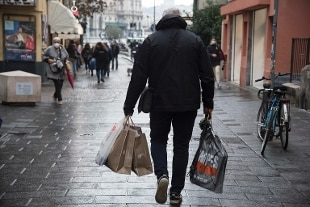Ansa archive photo
Share
23 January 2021 Covid effect on prices in 2020 in Italy with a small number of cities where there was an increase in average spending, in the lead Bolzano (+254 euro per family), Grosseto (+208) and Cosenza (+138) and a a much larger number where there was a sharp decline, with Venice in first place and savings of 187 euros per family. This is what appears, as reported by Ansa, from a study of the National Consumers Union carried out by processing Istat data which underlines how Italy as a whole in 2020 is in deflation for the third time since 1959.
In the year just ended in fourth place for increases Naples which, with the third highest inflation, + 0.6%, has an increase for an average family, equal to 131 euros on an annual basis. In fifth place, Perugia, where + 0.5% determines a growth of 119 euros. Followed by Trento (+ 0.5%, +117 euros), Trapani (+ 0.5%, +98), in eighth position Benevento (+ 0.3%, +61), then Arezzo (+ 0.2% , + 52), closes the top ten Novara (+ 0.2%, +49 euro). While 19 cities are experiencing price growth, 47 are in deflation.
At the top of the ranking of the most saving cities if Venice, where the record price collapse of 0.7 in 2020 allowed a saving of 187 euros for an average Venetian family. Second is Aosta, where the 0.7% drop is equivalent to a lower annual expenditure of 178 euros, on the lowest step of the Verona podium, -0.7% equal to -177 euros. Followed by Siena, -0.6% equal to -156 euro, and in fifth Milan, where the price reduction of 0.5% is equivalent to -145 euro.
"The 0.2% drop in prices allowed an Italian family to save an average of 47 euros, limiting the fall in purchasing power due to the decline in households' disposable income" said Massimiliano Dona, president of the National Consumers Union.
At the regional level, all the cities of Liguria (record in La Spezia: -0.5%, -114 euros), of Lombardy (Milan: -0.5%, -145 euros), Emilia Romagna (record in Bologna) are in deflation : -0.5%, -141 euro), Marche (Macerata: -0.4%, -86 euro) and Lazio (primacy in Rome, -0.4%, -104 euro). In Tuscany the highest disparities. In fact, we go from + 0.8% in Grosseto, equal to +208 euros, to Siena, where the -0.6% translates into a lower expenditure of 156 euros compared to 2019, a gap of 364 euros.
No cities in deflation in Campania (the largest increases in Naples, + 0.6%, +131 euros) or in Umbria (Perugia: + 0.5%, +119 euros). In Calabria it goes from + 0.7% in Cosenza (+138 euros) to -0.1% in Reggio Calabria (-20 euros), in Sicily from + 0.5% in Trapani (+98 euros) to -0 , 1% of Catania (-21 euros), in Veneto from the zero change of Belluno to -0.7% of Venice, in Friuli Venezia Giulia from + 0.1% of Trieste (+24 euros) to -0.2% Udine (-47 euro), in Sardinia from unchanged prices in Cagliari to -0.3% in Sassari (-60 euro).
Bad price slowdown, the Consumers Union points out, is not always good news: "The fact that the North is all in deflation is the demonstration of how Italy's economic engine has stopped. Venice is the most striking case and symbolic, being the Italian city with the highest price contraction. The collapse of tourism has precipitated the demand for some services. It is not for nothing that Venice has the record for the reduction in the price lists of accommodation services (-10.4% , against an Italian average of -1.6%) and hospitality and catering services (-2.4%, against + 0.5% in Italy) ".

